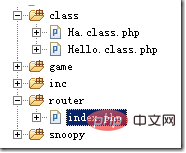
So implementiert PHP die URL-Routenverteilungsfunktion: Fangen Sie zuerst den Pfad [/router/] in der Serverkonfiguration ab, implementieren Sie dann den Routenverteiler, erhalten Sie den angeforderten URI und schreiben Sie schließlich das Modul.

【Verwandte Lernempfehlungen: php-Grafik-Tutorial】
So implementieren Sie die URL-Routing-Verteilungsfunktion in PHP:
Der erste Schritt besteht darin, den Server zu konfigurieren. Intercept the /router/ path/router/路径进行拦截

调用某个文件夹目录下的index.php


Rufen Sie die Seite index.php in einem bestimmten Ordnerverzeichnis auf. Das Verzeichnis befindet sich jetzt in separaten Dateien im Klassenverzeichnis Dieselbe Ebene wie der Router, wie in der folgenden Abbildung dargestellt:
<!Doctype html>
<html>
<head>
<title>路由测试~~</title>
<meta http-equiv="content-type" content="text/html; charset=utf-8" />
</head>
<body>
<?php
date_default_timezone_set("Asia/Shanghai");
define("MODULE_DIR", "../class/");
$_DocumentPath = $_SERVER['DOCUMENT_ROOT'];
$_FilePath = __FILE__;
$_RequestUri = $_SERVER['REQUEST_URI'];
$_AppPath = str_replace($_DocumentPath, '', $_FilePath); //==>\router\index.php
$_UrlPath = $_RequestUri; //==>/router/hello/router/a/b/c/d/abc/index.html?id=3&url=http:
$_AppPathArr = explode(DIRECTORY_SEPARATOR, $_AppPath);
/**
* http://192.168.0.33/router/hello/router/a/b/c/d/abc/index.html?id=3&url=http:
*
* /hello/router/a/b/c/d/abc/index.html?id=3&url=http:
*/
for ($i = 0; $i < count($_AppPathArr); $i++) {
$p = $_AppPathArr[$i];
if ($p) {
$_UrlPath = preg_replace('/^\/'.$p.'\//', '/', $_UrlPath, 1);
}
}
$_UrlPath = preg_replace('/^\//', '', $_UrlPath, 1);
$_AppPathArr = explode("/", $_UrlPath);
$_AppPathArr_Count = count($_AppPathArr);
$arr_url = array(
'controller' => 'index',
'method' => 'index',
'parms' => array()
);
$arr_url['controller'] = $_AppPathArr[0];
$arr_url['method'] = $_AppPathArr[1];
if ($_AppPathArr_Count > 2 and $_AppPathArr_Count % 2 != 0) {
die('参数错误');
} else {
for ($i = 2; $i < $_AppPathArr_Count; $i += 2) {
$arr_temp_hash = array(strtolower($_AppPathArr[$i])=>$_AppPathArr[$i + 1]);
$arr_url['parms'] = array_merge($arr_url['parms'], $arr_temp_hash);
}
}
$module_name = $arr_url['controller'];
$module_file = MODULE_DIR.$module_name.'.class.php';
$method_name = $arr_url['method'];
if (file_exists($module_file)) {
include $module_file;
$obj_module = new $module_name();
if (!method_exists($obj_module, $method_name)) {
die("要调用的方法不存在");
} else {
if (is_callable(array($obj_module, $method_name))) {
$obj_module -> $method_name($module_name, $arr_url['parms']);
$obj_module -> printResult();
}
}
} else {
die("定义的模块不存在");
}
?>
</body>
</html>Verwandte Lernempfehlung:
PHP-Programmierung
Das obige ist der detaillierte Inhalt vonSo implementieren Sie die URL-Routing-Verteilungsfunktion in PHP. Für weitere Informationen folgen Sie bitte anderen verwandten Artikeln auf der PHP chinesischen Website!
 So öffnen Sie eine PHP-Datei
So öffnen Sie eine PHP-Datei
 So entfernen Sie die ersten paar Elemente eines Arrays in PHP
So entfernen Sie die ersten paar Elemente eines Arrays in PHP
 Was tun, wenn die PHP-Deserialisierung fehlschlägt?
Was tun, wenn die PHP-Deserialisierung fehlschlägt?
 So verbinden Sie PHP mit der MSSQL-Datenbank
So verbinden Sie PHP mit der MSSQL-Datenbank
 So verbinden Sie PHP mit der MSSQL-Datenbank
So verbinden Sie PHP mit der MSSQL-Datenbank
 So laden Sie HTML hoch
So laden Sie HTML hoch
 So lösen Sie verstümmelte Zeichen in PHP
So lösen Sie verstümmelte Zeichen in PHP
 So öffnen Sie PHP-Dateien auf einem Mobiltelefon
So öffnen Sie PHP-Dateien auf einem Mobiltelefon